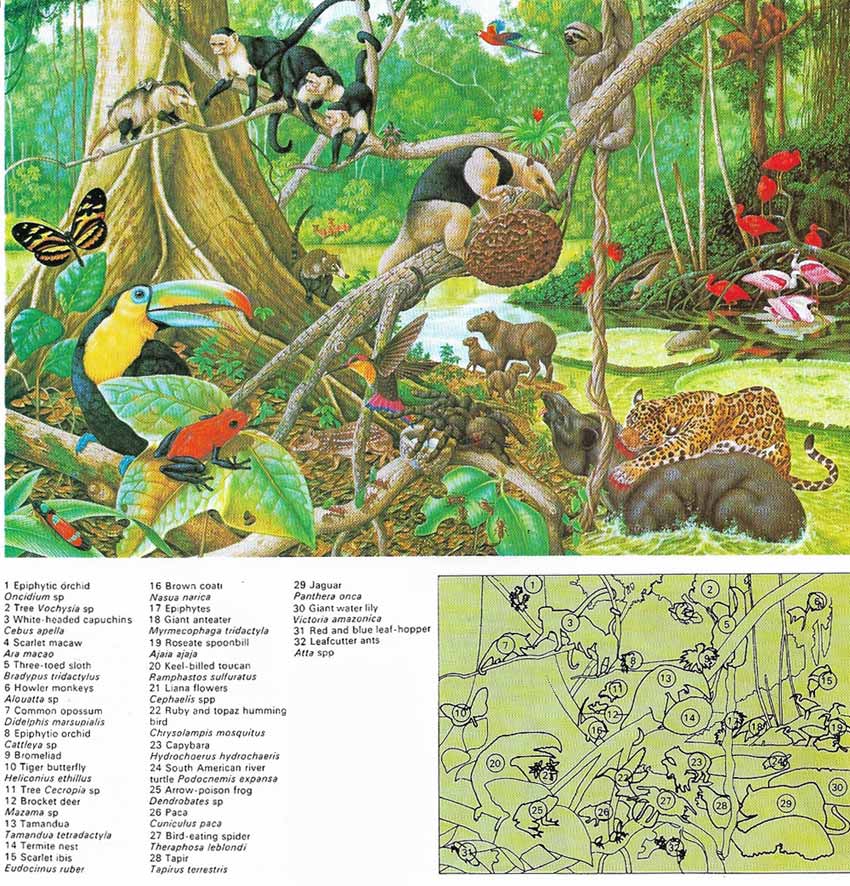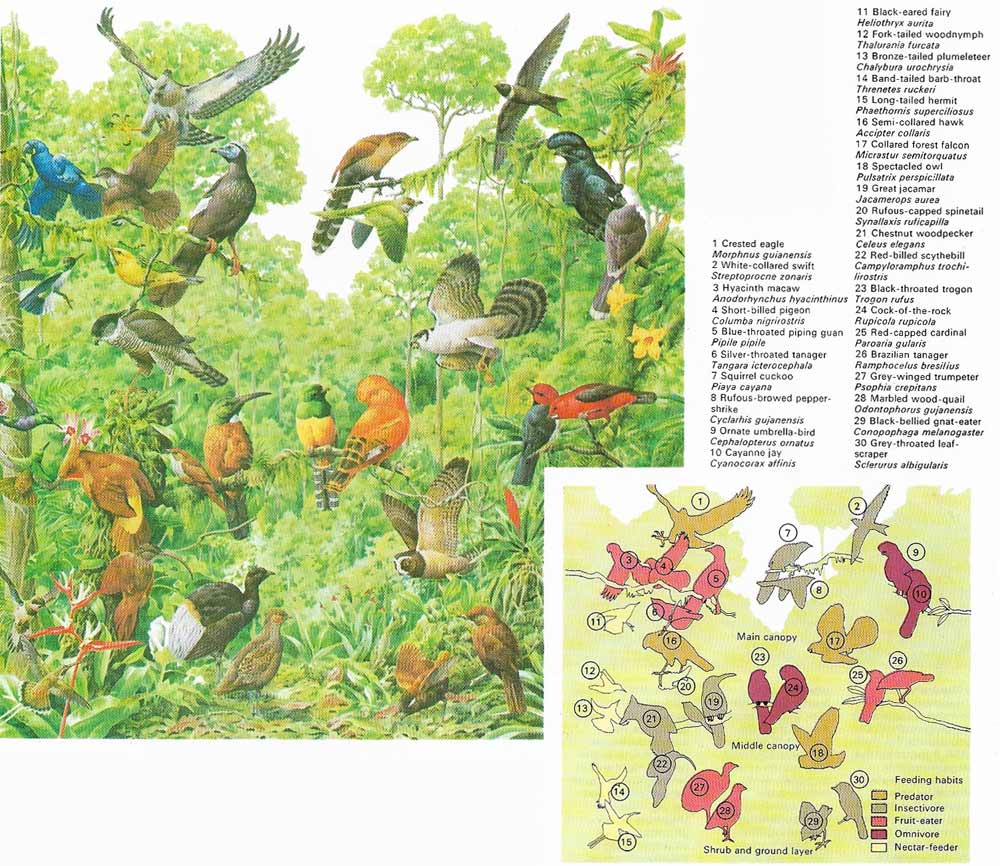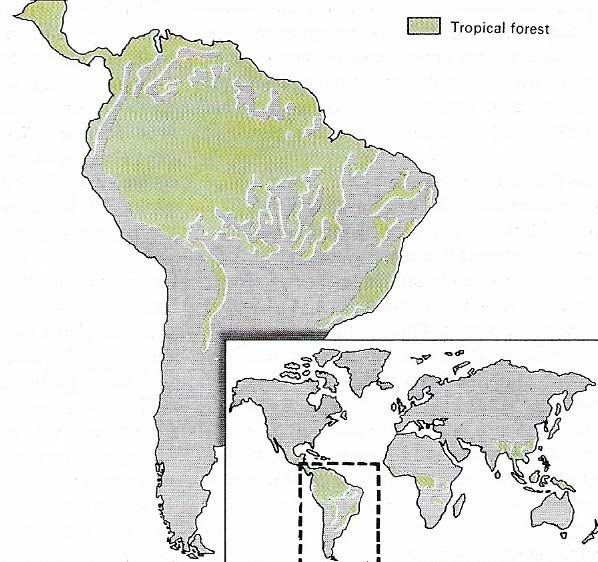New World tropics

Figure 1. The dominant features of the forest are the trees and the water; as a result, most of the animals living there are either arboreal or aquatic or sometimes both. Every singe niche in this enormous habitat is fully occupied with a bewildering collection of animals and plants. The huge trees are supported by buttress roots in the often unstable soil and are festooned with long lianas. Epiphytes, such as the startlingly beautiful orchids and bromeliads, abound on tree trunks and branches. The numerous rivers provide homes for millions of fish. There are a number of aquatic or semi-aquatic creatures that use the rivers at their base. These include reptiles such as terrapins, alligators, and anacondas. Wading birds such as the roseate spoonbill and scarlet ibis are also found on or by the river. Many animals liver at the water's edge, browsing on aquatic plants. They include the tapir and the world's largest rodent – the capybara. The shy paca roams the forest floor amid millions of insects and many species of frogs and reptiles. But most animals live high up in the forest canopy. There, troops of monkeys show off their acrobatic skills and the sloth lives up to its name with its funereal progress through the branches. Most of the birds also live in the canopy. They range in size from the big-billed toucan to tiny hummingbirds that flit from flower to flower like iridescent jewels. The solitary jaguar is fond of water and often chases tapirs and capybaras right into the river. It also feeds on fish and alligators which it catches in shallow parts of the river.

Figure 2. The birds of South American forests are more numerous and vividly colored than any others. The complex ecosystem provides an abundance of habitats and a very wide variety of food to sustain them. The unvarying climate ensures a year-round food supply and, as a result, birds do not have to migrate to escape harsh conditions. These factors also mean that birds need move only within a restricted area. Most of then have short, wide wings for maneuvering between the trees. The swifts rarely enter the forest but hunt for insects over the canopy. Their wings are long and narrow for fast flying. The most abundant foods are insects and the fruits of plants, and many forest birds feed on these. Hummingbirds feed on both insects and nectar. Many daytime birds of prey feed only on other birds but some like the eagles also eat mammals. Owls normally hunt at night and feed on any prey small enough to catch.

Figure 3. The great South American rainforest covers he low-lying Amazon basin and extends eastward to the Guianas and westward to the foothills of the Andes mountains.
Enveloping the basin of the Amazon in a shroud of dense vegetation is the greatest continuous mass of rainforest in the world. The abundance of water and the warm, humid climate support dense stands of trees that are festooned with creeping and climbing lianas. The forest floor receives little light and is the home of dark-colored animals that prefer a cool, damp environment. High above is the forest canopy, a continuous collection of tree tops broken only by tall, scattered emergent trees. It is here that most of the light is filtered out and where an abundance of animal life resides.
The exuberant vegetation provides a wide range of habitats for a remarkable variety of animals, although they are not usually densely distributed and the visitor may see few of them. The lack of seasonal variation in temperature guarantees a supply of food for these animals throughout the year.
Fish, insects and birds
The number of different species of fish in the rivers and insects in this tropical rainforest is so vast that they have never been fully classified. Small predators, especially the birds, grow fat at their expense, living in colonies along the banks of the rivers. The insects are remarkable not only for their numbers but also for their size and way of life. The Hercules beetle (Dynastes Hercules) measures up to 15 centimeters (6 inches) in length and is rivaled in size only by the bird-eating spiders (Theraphosa spp) which grow up to 25 centimeters (10 inches) across, feeding on small animals of all kinds. Butterflies are remarkable for their beautiful coloring but some of the most fascinating insects are the ants. Leaf-cutter ants (Atta spp) dissect leaves and carry them off to build compost heaps where they grow and "farm" the fungi on which they feed.
It is the birds of the forest that represent the most diverse adaptations to the numerous habitats and which exploit the various food sources without undue competition. They include macaws, pigeons, tanagers, and the delicate hummingbirds, all of which feed almost entirely on plants and their products. The insectivores are specialized in their feeding habits, swifts take insects in flight, woodpeckers feed on bark insects, cuckoos eat venomous wasps and a while family, the Formicariidae, feed entirely on the abundant supply of ants. High in the canopy hawks and owls patrol the forest, preying on reptiles, birds, and small mammals.
Mammals and other land animals
In comparison to the birds, mammals are poorly represented. Land mammals tend to be small, like the shy brocket deer(Mazama sp) which is only 91 centimeters (3 feet) long. The habitat usually occupied by deer is here exploited by rodents such as the agouti (Dasyprocta sp) and the paca (Cuniculuspace). But the region can also boast the largest rodent in the world, the peaceful capybara (hydrochoerus hydrochaeris), which lives in large family groups o the banks of the rivers. Two of the strangest creatures in this land of contrasts are the anteater and the tapir. The great anteaters or any bears (Myrmecophaga tridactyla) are solitary animals that roam the swampy areas of the forest, while another anteater, the tamandua (Tamandua tetradactyla), has become arboreal. The tapir (Tapirus terrestris), a relation of the horse and rhinoceros, belongs to a family of animals that was formerly widespread but is now confined to Central and South America and similar habitats of southeastern Asia. It is nocturnal and feeds on vegetable matter. Other ancient residents include marsupials, made up of a group of opossums, of which the common opossum (Didelphis marsupialis) is found as far north as the southern states of the United States. The only aquatic marsupial present, the yapok (Chionectes minimus), hunts by night for frogs, fish, and crustaceans.
In the higher levels of the tree canopy the inhabitants vary from extremely agile, acrobatic monkeys to slow-moving sloths – both the three-toed (Bradypus tridactylus) and the two-toed (Choloepus hoffmanni) kinds. The monkeys differ from their counterparts in the Old World, having evolved quite separately. They are divided into two groups, the marmosets and the cebid monkeys, Marmosets are the smallest primates in the world – the pygmy marmoset (Cebulla sp) grows only 7–10 centimeters (3–4 inches) in length. The cebids are more diverse in their appearance. They include the agile spider monkey (Ateles sp); the howler monkey (Alouatta sp), which has the most powerful vocal call of all the primates, and whose roars can be herd for miles; and the only truly nocturnal monkey, the large-eye douroucoulis (Aotus sp).Bats also abound in the forest. Some, such as the fruit bats, are herbivorous, others are insectivorous and yet others entirely carnivorous. One of the most notorious is the vampire bat (Desmodus rotundus) which pierces the skin of warm-blooded animals with its sharp teeth and drinks the fresh blood.
Numerous predators
The vast array of animal life supports many predators including larger reptiles such as the giant anaconda (Eunectes murinus), the smaller boa constrictor (Constrictor constrictor) and alligators and caimans. The largest mammalian predator is the jaguar (Panthera onca), one of the resident cat family that includes the puma (Felis concolor), ocelot (Felis pardalis), margay (Felis weidii), and the jaguarondi (Felis yagouaroundi).


